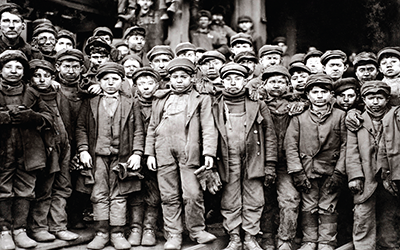Child Labor
Driving Question: How did ideas about child labor shift during the long nineteenth century, and what brought about those changes?
During the long nineteenth century, many kids went to work in factories and mines, and the appalling conditions for child laborers led to a new idea: Maybe children should be schooled and nurtured, rather than employed and exploited. But how exactly did the role of children as workers transform during the long nineteenth century?
Learning Objectives:
- Analyze how shifts in ideas about childhood led to labor reforms in the long nineteenth century.
- Use the historical thinking skill of contextualization to examine the use of child labor and why perceptions changed during this era.
Vocab Terms:
- abolition
- activist
- factory
- industrial capitalist
- manufacturing
- reform
- textile
Opener: Child Labor
To teach this lesson step, refer to page 2 of the Lesson 5.7 Teaching Guide.
Occasionally, one quote can tell us everything we need to know about something. Let’s see what understanding you can gain from this quote about child labor during the Industrial Revolution.
Child Labor Reforms
AI Detective: Reformers and Their Opponents—Real and Imagined
- Ask AI to generate a set of quotes from reformers and their opponents. Ask for several false quotes including misattributions, misdates, and quotes from people who never existed.
- Then, ask students to read the quotes and flag anything that seems suspicious. Together, label each claim as “true,” “needs revision,” or “false,” and discuss why.
- Why this works: This activity strengthens source analysis and skepticism. Students confront AI’s tendency to invent information, learning to validate claims with historical evidence and deepening their understanding of real reform debates.
Check out our guide on Using AI Tools with OER Project for more tips on using AI in the classroom.
In the nineteenth century, the lives of many children were filled with hard work under dangerous conditions. This activity and article will help you understand how reform movements started to change this.
-
Guiding Questions
-
Before you read
Preview the questions below, and then skim the article. Be sure to look at the section headings and any images.
While you read
Look for answers to these questions:
- Why did formal child labor increase during this period, especially in Europe and the United States,?
- What was the moral objection to child labor?
- How and why did labor unions argue against child labor?
- Once child labor was outlawed, what did children usually end up doing?
- How did reforms in child labor impact areas in colonized Asia and Latin America?
After you read
Respond to this question: How did reformers communicate their ideas about child labor to the public?
Children at Work
To teach this lesson step, refer to page 7 of the Lesson 5.7 Teaching Guide.
This discussion in the OER Project Community forum connects the Sadler Report to our world today.
Thanks to industrialization, children increasingly found themselves in dangerous jobs working long hours. That started to change, thanks to reformers who publicized the problem.
-
Guiding Questions
-
Before you watch
Preview the questions below, and then review the transcript.
While you watch
Look for answers to these questions:
- Why did some children begin work as nailers at five years of age?
- How many nails would an eight-year-old girl be expected to make in one hour? How many hours did nailers work?
- How did the nail masters cheat the nailers? How much did the nail master usually pay the nailers per week?
- Who was Mary-Ann Bird?
After you watch
Respond to this question: How does learning about Victorian nailers help you understand the perils of child labor and the power dynamics between the working and industrial classes?
Key Ideas
Closer: Child Labor
To teach this lesson step, refer to page 9 of the Lesson 5.7 Teaching Guide.
Our Openers and Closers Guide will provide more information about these short, but important, activities at the beginning and end of each lesson.
This quick skill-building activity will help you understand what is being asked of you when you’re presented with historical prompts.
Labor Data
To teach this lesson step, refer to page 9 of the Lesson 5.7 Teaching Guide.
Our Data Literacy Guide provides a summary of strategies to help students read the data, read between the data, and read beyond the data.
The story of child labor extends beyond England, and, sadly, it extends beyond the long nineteenth century. This data exploration will help you understand how child labor changed, from the Industrial Revolution to the present.
-
Guiding Questions
-
Before you read
Preview the questions below, and then skim the article. Be sure to look at the section headings and any images.
While you read
Look for answers to these questions:
- Chart 1 shows a spike, when child labor in Italy started rising again instead of falling. Why do you think this spike occurred? Why don’t we see a similar spike in the UK or US?
- Charts 1 and 3 show dramatic decreases in child labor. Why does Chart 2 not show this sort of dramatic decline?
- What does Chart 4 measure? Why do you think the percentages are so much higher than at the ends of Charts 1, 2, and 3?
- Why do you think Chart 5 lists “no data” for wealthy countries in Europe, North America, and elsewhere?
- There’s a lot of data missing from the “global” information in Charts 4 and 5. What impact does this have on our understanding of child labor?
After you read
Respond to this question: What do these charts about child labor tell us about human communities since the Industrial Revolution?





